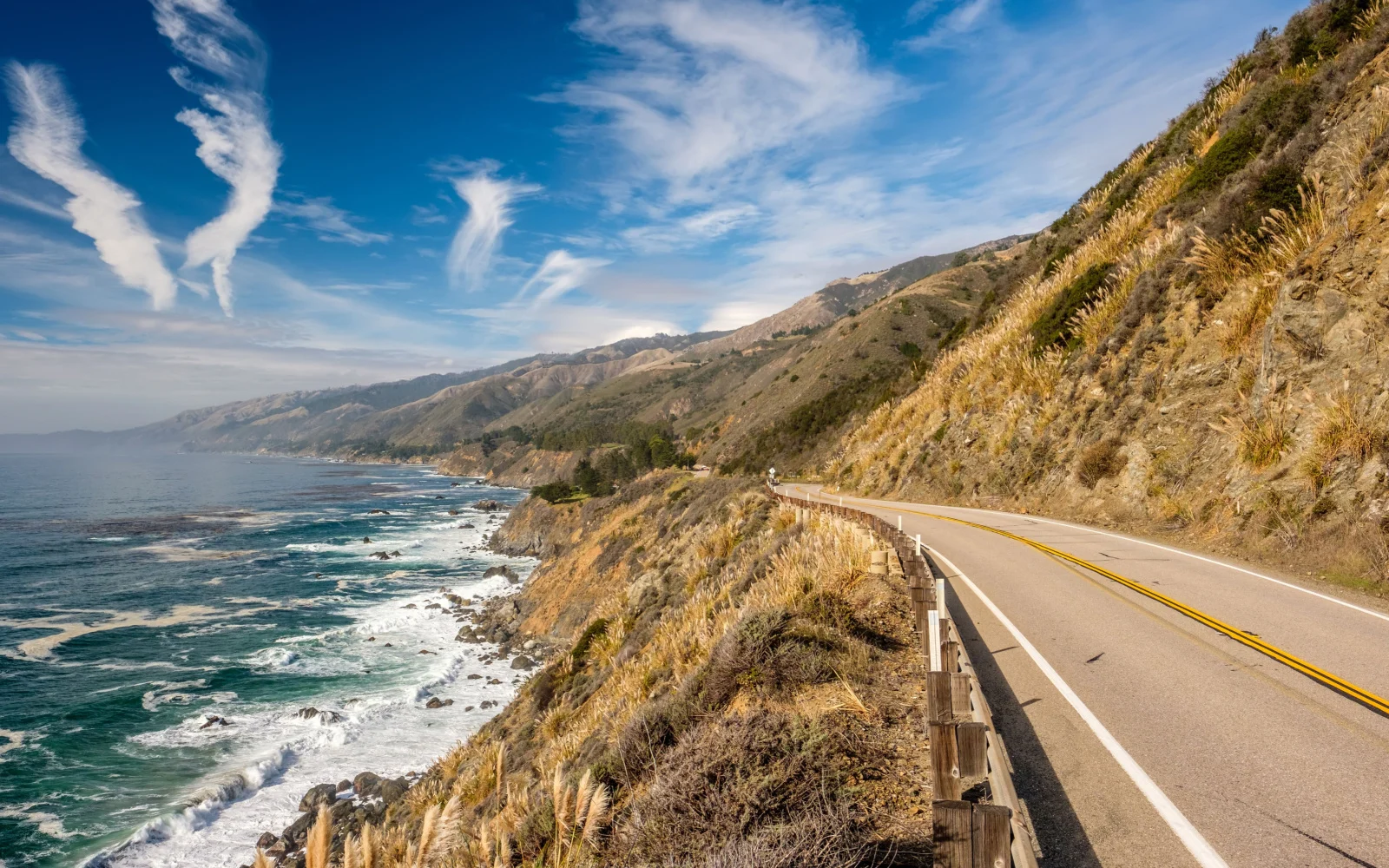The Northern California vs Southern California comparison is an important one if you’re planning a trip soon or are thinking about making a more permanent move to The Golden State.
In this comparison, we’ll take a look at the major contrasts between the Northern and Southern regions of the huge state of California to help you decide which one’s a better fit for you.
Northern California vs Southern California Overview
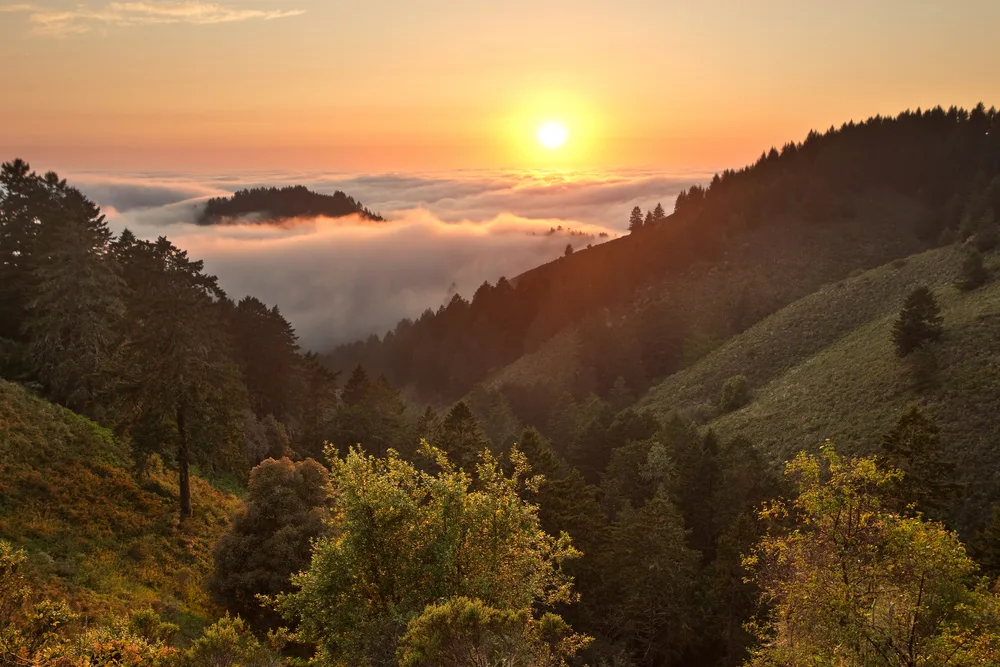
Matt Tilghman/Shutterstock
These regions may as well be different states, with their vast differences in terms of culture, geography, population, cost, and climate.
Teasing apart the differences between Northern California vs Southern California will help you settle on the region that’s a better fit for your trip or move.
Northern California (NorCal), with its towering redwood and sequoia forests, expansive national parks, mountains, rocky beaches, and huge agricultural regions, is much bigger than Southern California.
It’s also the hub of the modern finance and technology industry in Silicon Valley, deeply rooted in progressive causes, and a mild climate that boasts bearable temperatures with moderate heat in the summertime.
Southern California (SoCal) is famous for its sunny, warm beaches, vast deserts, dry climate, and the entertainment hub of Hollywood in Los Angeles. It has a larger population but is a smaller region than NorCal.
We’ll look at the differences between Northern California vs Southern California in the following categories:
- Major cities
- Climate
- Culture
- Cost
Keep reading to see what makes NorCal different from SoCal and which region will be better to visit or move to!
The Major Cities
While Southern California is smaller in area than Northern California, it has more major cities and a larger population size – even with the low-population desert regions in the South.
That’s because Southern California is the hub for the nation’s entertainment industry in Hollywood.
Major cities in these regions include famous cities in high-population metropolitan areas like San Francisco, San Jose, Los Angeles, and San Diego.
Northern California Major Cities
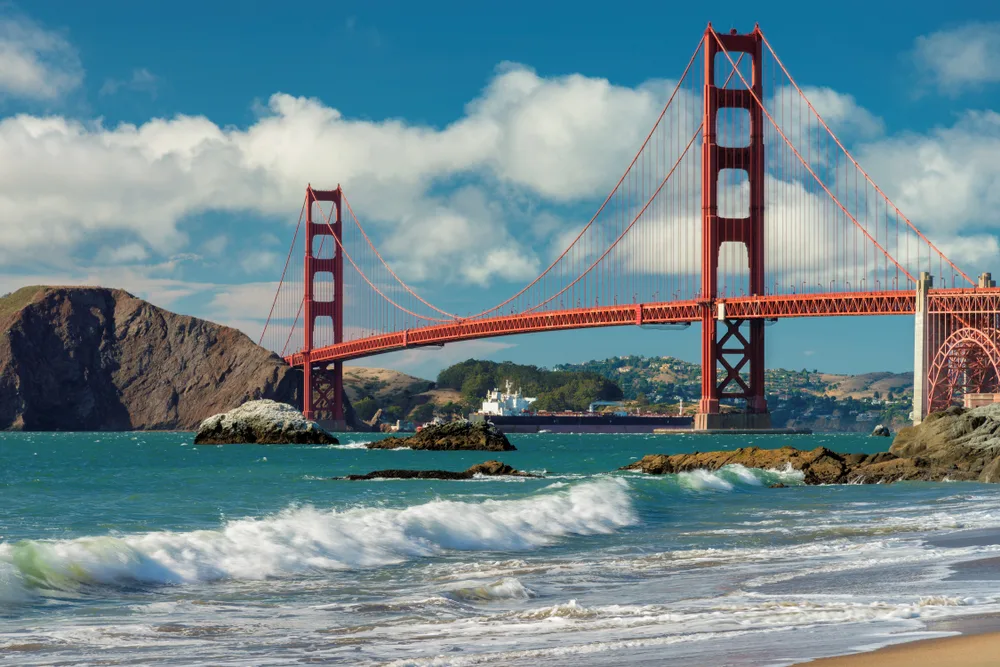
Lucky-photographer/Shutterstock
Northern Calfornia’s major cities include:
- San Jose
- San Francisco
- Fresno
- Sacramento
- Oakland
San Jose is Northern California’s most populated city with around 971,200+ inhabitants. It’s the center of Silicon Valley, so even more people commute to offices in the city each day.
San Jose is in a valley surrounded by lush hills and known for Italian-style and Spanish Colonial Revival architecture throughout the downtown area.
San Francisco, the 2nd most populated city in Northern California with around 815,200+ inhabitants. Lots of people commute to the Bay Area as it’s a hub for finance and technology.
San Francisco is the cultural center of Northern California and known for the Golden Gate Bridge, rocky beaches, steep hills, cable cars, and colorful mix of Victorian homes and modern architecture.
Fresno is the 3rd most populated city (544,500+) in Northern California, but it’s technically situated in the Central Valley. It’s in the San Joaquin Valley and a gateway to Yosemite National Park.
Fresno is big on natural beauty and features the interesting Forestiere Underground Gardens with catacomb-like tunnels and courtyards. Lush parks and gardens dominate the relatively-flat terrain.
Southern California Major Cities
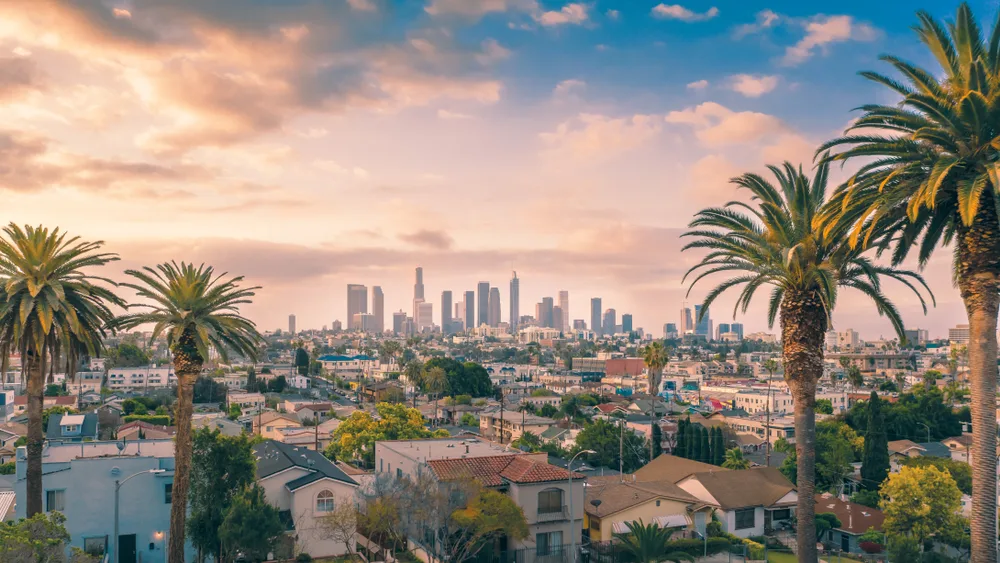
Marek Masik/Shutterstock
Southern California’s major cities include:
- Los Angeles
- San Diego
- Long Beach
- Anaheim
- Santa Ana
Los Angeles is the most populated city in Southern California with over 3.849 million people living in its large area that includes Hollywood, Beverly Hills, Venice, and Echo Park.
Los Angeles is the most famous major city in Southern California and it’s where the Hollywood entertainment industry is rooted. It’s where you’ll find iconic landmarks like the Hollywood sign, TCL Chinese Theater, and movie studios.
San Diego is the 2nd most populated city in Southern California with 1.382 million people living there. It’s just north of the border with Mexico and located right on the Pacific Coast.
San Diego one of the most popular destinations in SoCal, known for beaches, gardens, museums, a massive zoo, and parks. Because it’s in Southern California, it enjoys warm, mild weather year-round.
Long Beach is the 3rd most populated city in Southern California, but there’s a large gap between it and San Diego with only 462,250+ people living there currently.
Long Beach is known for its laid-back culture with surfing and skating being popular here starting in the early 1930s. Today, it’s a beach-focused town with a big aquarium, art galleries, adobe homes, and permanently docked historic ships in the harbor.
The Average Climate
Northern California is slightly cooler, wetter, and foggier than the warmer, drier conditions in Southern California. The differences are subtle but most noticeable when it comes to going to the beach or visiting during the winter.
While Northern California’s average temperatures are slightly lower than Southern California’s throughout the year, Northern California actually has a hotter summer than the Southern region.
Temperatures peak at highs around 92-97F in the summer in Northern California, but only reach highs from 88-95F during Southern California summers.
Rainfall totals are slightly higher in Northern California, reaching a maximum 3.7 inches in December compared to 2.3 inches in December in Southern California.
Northern California Climate
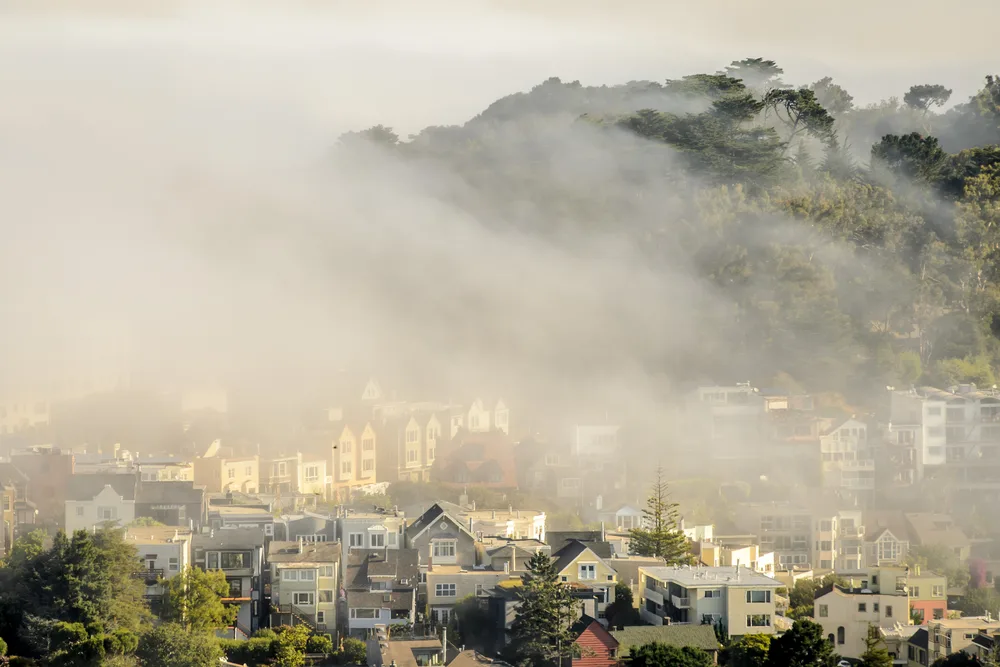
Tunde Gaspar/Shutterstock
Northern California enjoys mild weather throughout the year with damp, mild winters and warm, dry summers. It’s known for its foggy conditions that peak during the summer months.
San Francisco is especially famous for fog that cloaks the city in cooler temperatures. The fog is chilly, dense, and brings much-needed moisture to the massive redwoods and coastal cities along California’s northern coast.
Northern California sees average temperatures that range from 57-97F (daily highs) and 36-60F (daily lows) throughout the year.
June through September is the hottest period of the year in Northern California with July seeing the warmest temperatures in the upper 90s.
Here’s a look at the average monthly lows and highs around Northern California.
- January: 36-59F
- February: 40-63F
- March: 44-69F
- April: 46-75F
- May: 52-84F
- June: 58-93F
- July: 60-97F
- August: 59-96F
- September: 56-92F
- October: 50-80F
- November: 42-66F
- December: 37-57F
Conditions are pretty dry throughout the year in Northern California, which is why the fog is so important to the region’s forests, farms, and cities.
November through March is the wettest period for Northern California, with the maximum average rain amounts hitting their peak in December (3.7 inches).
Here’s a look at the average precipitation amounts across the region throughout the year:
- January: 2.3 in.
- February: 2.9 in.
- March: 2.2 in.
- April: 1.5 in.
- May: 0.7 in.
- June: 0.4 in.
- July: 0 in.
- August: 0 in.
- September: 0.2 in.
- October: 0.1 in.
- November: 2.1 in.
- December: 3.7 in.
Overall, Northern California enjoys a mild climate that’s wetter during the mild winter months and driest in the warm summertime.
Southern California Climate

Isogood_patrick/Shutterstock
Southern California’s climate is slightly warmer and drier than Northern California. This makes winters even milder than in the North with temperatures more reminiscent of springtime.
The temperature difference between seasons is much more subtle in Southern California than in the Northern region. Winter, from December to March, sees highs from 65-73F. Summer heats up to 88-95F.
Here’s a look at the average daily lows and highs in Southern California throughout the year:
- January: 36-68F
- February: 37-67F
- March: 40-73F
- April: 43-77F
- May: 49-81F
- June: 54-88F
- July: 61-93F
- August: 61-95F
- September: 58-93F
- October: 50-83F
- November: 41-75F
- December: 36-65F
The climate in Southern California feels more stable throughout the year, even though summers are a little cooler than in the North of the state.
Since temperatures don’t cool down in the winter as much, people like visiting Southern California year-round for warmer weather and sunny days on the beach.
In terms of precipitation, Southern California is drier than Northern California and sees less rainfall (and fog) throughout the year. Here’s a look at the average rainfall totals in the region:
- January: 1.2 in.
- February: 1.1 in.
- March: 0.7 in.
- April: 0.4 in.
- May: 0.2 in.
- June: 0 in.
- July: 0.2 in.
- August: 0.4 in.
- September: 0.1 in.
- October: 0.2 in.
- November: 0.5 in.
- December: 2.3 in.
While it’s drier throughout the year on average than the Northern region, Southern California actually has a slightly wetter summer period. However, the winters are drier in Southern California than in the North.
The Culture
The culture of Northern California is vastly different from Southern California – so much so that natives and people who live in each area can easily recognize someone from the other region upon meeting them.
While a lot of the cultural differences seem like stereotypes, there is a lot of truth to the archetypes of Northern and Southern California. Here’s a look at what makes their cultures different.
Northern California Culture

canadastock/Shutterstock
The culture of Northern California is global-minded, progressive, focused on education and financial success, and deeply rooted in climate consciousness and eco-friendly practices.
The culture here is faster-paced and feels more metropolitan than Southern California in some ways. Since this is where Silicon Valley is located, there’s a priority on productivity, success, and protecting the environment in the process.
Northern California’s culture is also built around the outdoor activities and geography of the area. People give great respect to the massive redwood and sequoia forests, national parks, rollings hills and valleys with vineyards, and dramatic beaches.
The food in Northern California is a little different from what you’ll find further south. Popular foods include garlic (everything from fries to ice cream), as well as lobster rolls, avocado toast, and sourdough bread with rich chowders.
Southern California Culture
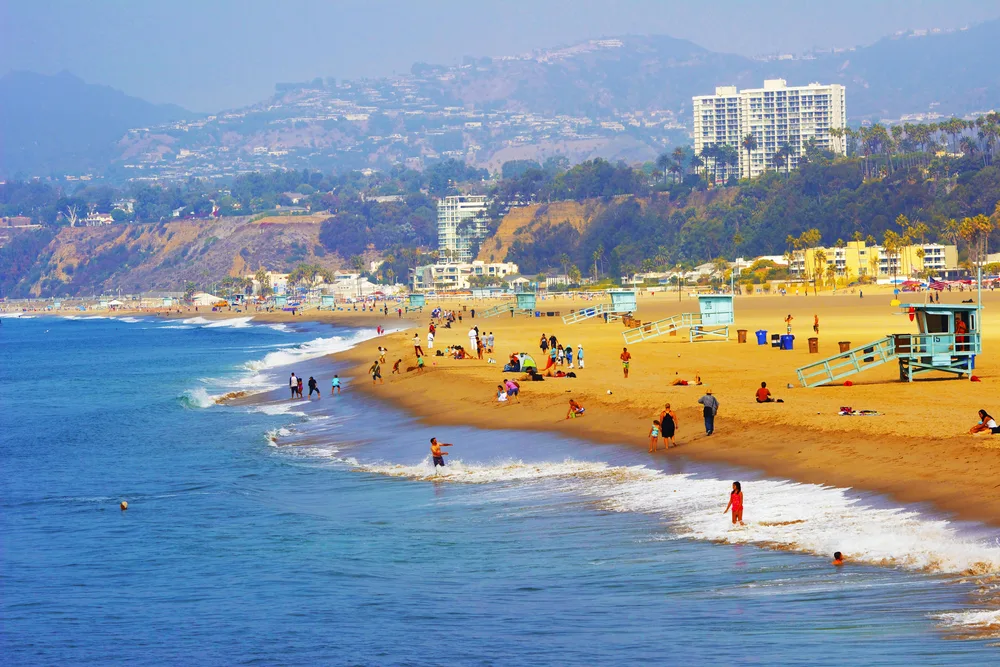
Andrea Reider/Shutterstock
Southern California’s culture is more laid-back and entertainment-centric than in the North. The culture here is focused on healthy living, fitness and athletics, beach and outdoor activities, and all things Hollywood.
The beaches and warm weather year-round contribute to a big focus on the laid-back beach lifestyle mixed with outdoor fitness and athletics from beach volleyball and surfing to skateboarding and team sports.
With such a large population, traffic is something all SoCal natives and locals can relate to and it’s definitely ingrained in the culture here. Music, movies, TV, and entertainment are always topics of conversation.
The food in Southern California focuses a lot on fusion cuisine from around the world, but there’s a lot of Mexican influence with its proximity to the border. Sushi, tacos, and healthy salads and wraps are popular here.
The Average Cost
The cost difference of living and visiting Northern California vs Southern California is somewhat significant. Northern California is more expensive to live in, but people also make more money in this region than in SoCal.
With notable differences in median household income, median home price, median rent, and average nightly hotel rates, it’s worth comparing the cost of the two regions to see which is a better option for your budget.
While it’s more expensive to live in NorCal, it’s slightly cheaper to stay here than in Southern California with lower hotel nightly rates. The difference is small at just $7-$79 less per night.
Northern California Cost
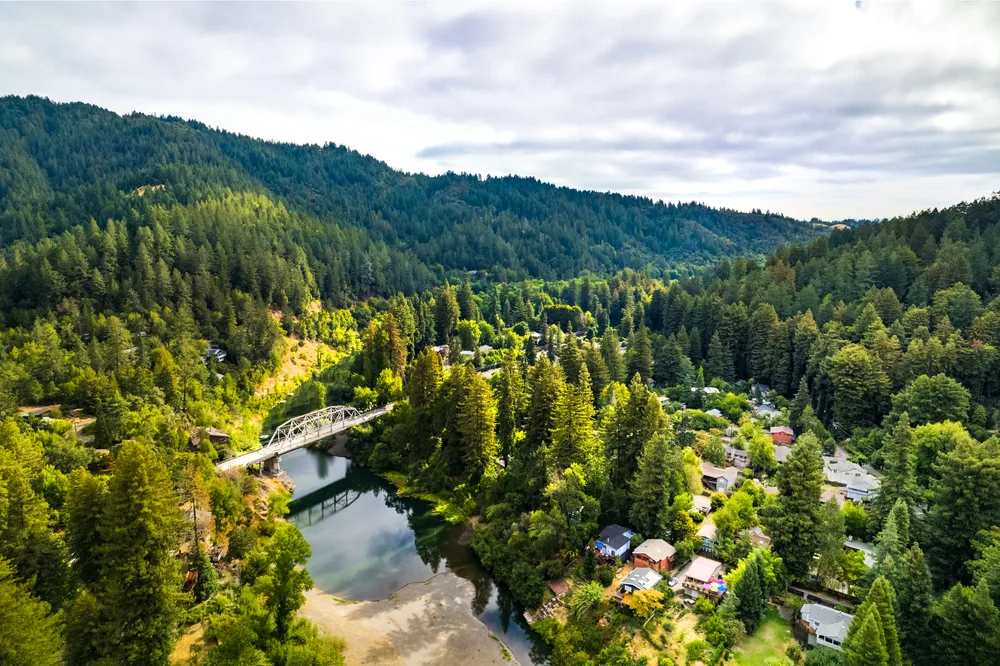
TCalli Captures/Shutterstock
- Median household income: $118,725
- Median home price: $1,268,749
- Median rent: $3,907/month
- Average hotel price: $75-$257/night
Living in Northern California is more costly than living in Southern California. The average household brings in nearly $119K annually, but the median home price here makes that a necessity at nearly $1.3 million.
Most renters pay around $3,900 per month to live in NorCal, but keep in mind that median prices mean roughly half of people here pay more and half pay less.
Staying in Northern California is a little less expensive than staying in Southern California. You’ll find rooms as low as $75/night on average in both San Francisco and San Jose.
But average room rates can be as much as $286/night in San Francisco, while the max average hotel price is closer to $229/night in San Jose.
Southern California Cost
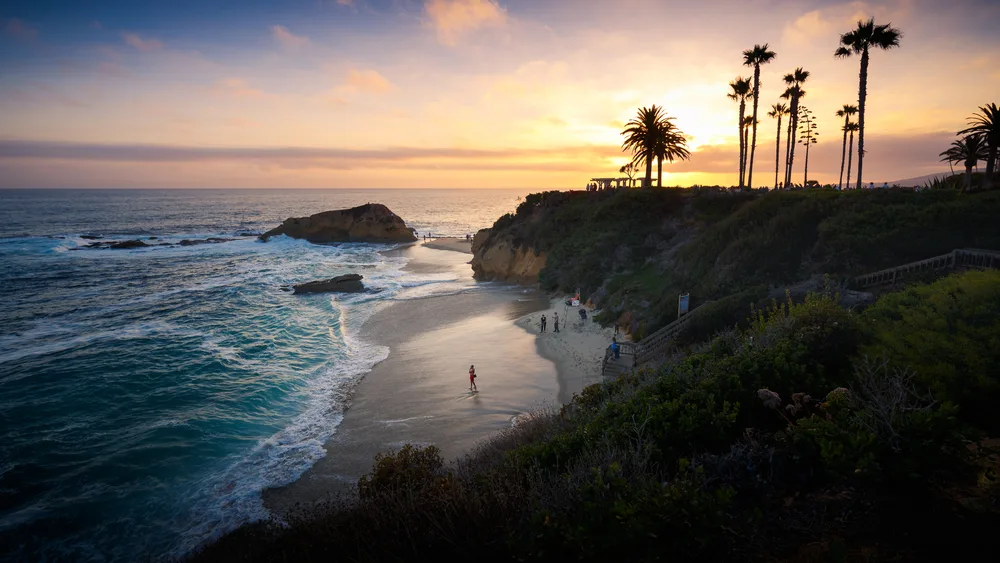
Engel Ching/Shutterstock
- Median household income: $71,060
- Median home price: $716,038
- Median rent: $3,125/month
- Average hotel price: $82-$336/night
Living in Southern California is less expensive than Northern California, but people tend to make less money and pay less for homes in this region.
The average household brings in around $71,000 annually in SoCal and median home prices are lower at around $716,000 throughout the region.
Home prices are a little higher in Los Angeles than in San Diego ($752.5K in L.A. vs. $679.5K in San Diego) and median rent prices follow the same pattern ($3,500 vs. $2,750, respectively).
Staying in Southern California is more expensive than NorCal, but not by much. This may be due to Southern California’s popularity with tourists and higher hotel demand.
The average hotel price is $79-$254/night in Los Angeles, but even higher in San Diego at $85-$418/night. It’s never truly “cheap” to stay in Southern California’s major cities, but you’ll find more affordable options around L.A. than in San Diego.
Things to Consider

Nick Fox/Shutterstock
We’ve got more tips for you to keep in mind if you’re planning on making a trip to NorCal or SoCal soon – or if you’re thinking about making a more permanent move!
- Lower costs by staying outside of major cities. If you want to visit Northern or Southern California, you can reduce your costs by choosing to stay in a suburb of one of the major cities and driving or taking public transportation into the metropolitan areas.
- Visit both regions for a “vibe check.” You can research and read about Northern California vs Southern California all day long, but in the end, only a personal visit will enable you to get a true sense of the different cultures and vibes of the two regions.
- Bring layers. California’s generally mild climate can be deceiving. While it’s usually warm throughout the day, you might surprised by chilly lows at night – especially in the North. If you’ll be visiting national parks or enjoying outdoor activities, it’s wise to pack layers in case it gets cooler unexpectedly.
- It’s cheaper to live in SoCal. It’s not truly cheap to live in any of California’s major cities, but you’ll find lower average home prices and rent in Southern California than in Northern California. It’s actually cheaper to stay in NorCal hotels than in SoCal, however.
- Do some exploring. No matter where you visit in California, it’s such a massive area with diverse geography, dramatic beaches, and beautiful national and state parks. There’s always somewhere beautiful to visit nearby! Even if you plan to visit a major city in California, make sure to get out and do some exploring to see the natural beauty nearby.
Frequently Asked Questions

Lucas Jaeger/Shutterstock
Getting a true sense of the differences between Northern California vs Southern California is easier when you can look at the most common questions travelers have about these two regions.
Take a look at the FAQs below to learn more about what makes them different!
Is it better to live in Northern or Southern California?
While both regions have their pros and cons, it’s generally better to live in Southern California due to the lower cost, warmer climate, great beaches with warmer ocean water, and reduced rainfall.
Southern California is flatter and hotter than Northern California, and most people think NorCal is prettier in landscape than SoCal. So it really depends on what you’re looking for to decide which place is better to live in!
Is Southern California better than Northern California?
Many people think Southern California is better than Northern California. The ocean water is warmer and the beaches less rocky, so it’s better for swimming and water sports.
It’s also warmer, drier, and less expensive to live here.
Why is Northern California so different from Southern California?
California is such a large, narrow state that the region of Northern California feels worlds away - geographically and culturally - from Southern California. From the politics to the food scene, these regions are very different.
NorCal is more progressive, geographically diverse, cooler, and rainier than SoCal. It’s also more expensive to live in and a bit faster-paced in lifestyle.
Is Northern California richer than Southern California?
Yes. Most of the counties with the highest income per capita are located in Northern California, where the cost of living, median household income, and median home price are all higher than in SoCal.
There are more billionaires living in Northern California (the Bay Area) than in Southern California as well.
Where do billionaires live in California?
The San Francisco Bay Area and Silicon Valley are home to the highest concentration of billionaires in the U.S. with around 63 billionaires currently living here.
Los Angeles has the 3rd-highest concentration of billionaires with 42 residing in or near the area.
Northern California vs Southern California: Which Is Better?
It’s hard to slap a label on Northern California vs Southern California to say which one is definitely better. They’re both full of pros and cons for a visit or a potential move.
Northern California is slightly cooler, wetter, more geographically diverse, progressive, and expensive than Southern California. The population is a little lower with its major cities being San Francisco and San Jose.
Southern California is a little warmer, drier, flatter, and (very slightly) more affordable than NorCal. The culture is more laid-back and fitness and health-oriented.
Its main features are beaches (warmer ocean water than NorCal) and deserts with huge population hubs in its major metropolitan areas around Los Angeles and San Diego.
Deciding which one is better means looking at your needs and desires for your trip or move. If hanging out on the beach, surrounded by palm trees and a focus on fitness sounds like your scene, opt for SoCal.
If massive stands of ancient redwood and sequoia trees amid mountains and valleys with rocky, cooler beaches and a more progressive political vibe sounds better, you’re all set for NorCal.
Either way, you’re in for a treat when you visit California – especially if you go at the best time of year!



